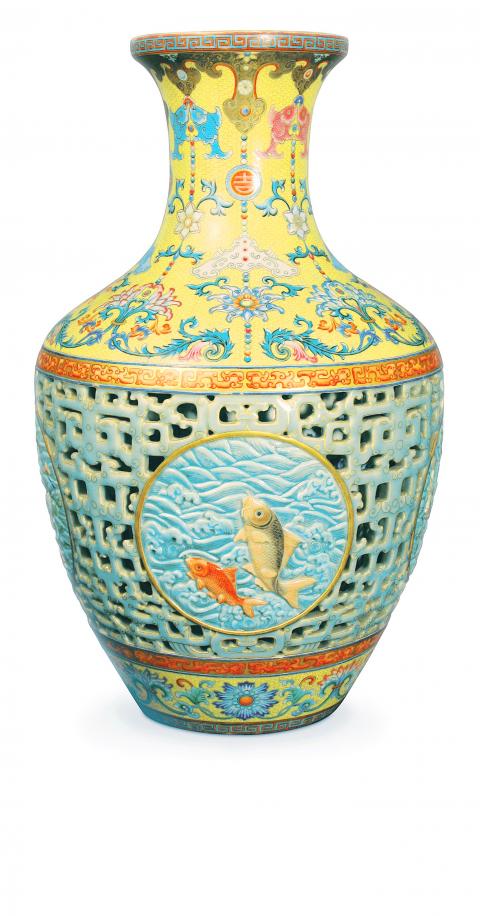A Chinese vase for which a bidder offered a record US$83 million at auction more than two years ago has been sold for less than half the price the original purchaser failed to pay.
The elaborately decorated 18th-century porcelain vase, described as being made for the Qianlong Emperor, was auctioned by Bainbridges in Ruislip, west London, on Nov. 11, 2010.
The winning bid was more than 50 times the presale estimate. The price, including auction house fees, was a record for any Asian work of art offered at auction. The bid was made by an agent in the room on behalf of the Beijing-based collector, Wang Yaohui, according to a person familiar with the transaction.

PHOTO: AFP
The owners, a retired solicitor called Tony Johnson and his mother Gene, waited two years for a resolution. They have now sold the vase to another buyer for an undisclosed price between US$32 million and US$40 million, said a person with knowledge of the matter.
The private transaction was brokered by the London-based auction house Bonhams. The vase has now been exported. The new owner has been identified by dealers as an Asian collector.
“Bonhams is pleased to confirm the sale of the vase for an undisclosed sum, in a private treaty deal,” according to an email from Julian Roup, Bonhams’s director of press and marketing.
House Clearance
“It’s the right price,” the London-based dealer Roger Keverne said in an interview. “That was the figure at which most people were interested when the vase was originally offered. It’s settled to its true value.”
Keverne said dealers would be relieved the two-year non- payment saga had been resolved. “It’s good news,” he said. “This was an itch that needed dealing with. It was at least so far out of the reach of normal trading that it didn’t affect overall levels of confidence. That [US$83] million was a casino price.”
The Qing-dynasty rarity, featuring a pierced “reticulated” body painted in a pastel-colored “famille rose” palette, was discovered during a routine house clearance in the London suburb of Pinner.
In perfect condition, the vase had been owned by William and Pat Newman, who died in 2006 and 2010 respectively. It then passed to Pat Newman’s sister, Gene. It isn’t known how William Newman acquired the piece.
The record bid for the so-called “Ruislip Vase” was the highest of a series of big-ticket prices for imperial Chinese porcelain that were pledged, if not always paid, by Asian bidders at auctions in 2010.
Sale Value
Auction sales of art and antiques in China in 2010 were valued at US$8.6 billion, a 177 percent increase on 2009, according to a European Fine Art Foundation report published in March 2011.
Further auctions and dealer transactions in the West turned the trade in Chinese artifacts into a business worth more than US$10 billion, according to Bloomberg calculations.
Demand for Chinese antiques has since declined as growth in the Chinese economy contracted and western auction houses introduced deposits to deter non-payers.
Though Bainbridges’s original bill for the imperial vase was never met in full, the auction house had received an interim payment, said persons with knowledge of the matter.
Peter Bainbridge, the company’s director, has consistently declined to comment on the non-payment of the vase, citing a confidentiality clause.
Web site Video
A video of the record-breaking auction still features on Bainbridges’s Web site and the vase is used in place of an “i” on the company logo.
Wang Yaohui, the Beijing-based chairman of Zhonghui Guohua Industrial Group Co, Ltd, has been named in connection with the 2010 bid by the China-based art news Web site en.artron.net and other Asian media sources.
He was unavailable for comment by telephone and did not respond to emails when Zhonghui Guohua was contacted by Bloomberg News yesterday.
Zhonghui Guohua is a conglomerate with interests that include real estate, hi-tech industry, construction and minerals.

In the next few months tough decisions will need to be made by the Taiwan People’s Party (TPP) and their pan-blue allies in the Chinese Nationalist Party (KMT). It will reveal just how real their alliance is with actual power at stake. Party founder Ko Wen-je (柯文哲) faced these tough questions, which we explored in part one of this series, “Ko Wen-je, the KMT’s prickly ally,” (Aug. 16, page 12). Ko was open to cooperation, but on his terms. He openly fretted about being “swallowed up” by the KMT, and was keenly aware of the experience of the People’s First Party

Aug. 25 to Aug. 31 Although Mr. Lin (林) had been married to his Japanese wife for a decade, their union was never legally recognized — and even their daughter was officially deemed illegitimate. During the first half of Japanese rule in Taiwan, only marriages between Japanese men and Taiwanese women were valid, unless the Taiwanese husband formally joined a Japanese household. In 1920, Lin took his frustrations directly to the Ministry of Home Affairs: “Since Japan took possession of Taiwan, we have obeyed the government’s directives and committed ourselves to breaking old Qing-era customs. Yet ... our marriages remain unrecognized,

Not long into Mistress Dispeller, a quietly jaw-dropping new documentary from director Elizabeth Lo, the film’s eponymous character lays out her thesis for ridding marriages of troublesome extra lovers. “When someone becomes a mistress,” she says, “it’s because they feel they don’t deserve complete love. She’s the one who needs our help the most.” Wang Zhenxi, a mistress dispeller based in north-central China’s Henan province, is one of a growing number of self-styled professionals who earn a living by intervening in people’s marriages — to “dispel” them of intruders. “I was looking for a love story set in China,” says Lo,

Standing on top of a small mountain, Kim Seung-ho gazes out over an expanse of paddy fields glowing in their autumn gold, the ripening grains swaying gently in the wind. In the distance, North Korea stretches beyond the horizon. “It’s so peaceful,” says the director of the DMZ Ecology Research Institute. “Over there, it used to be an artillery range, but since they stopped firing, the nature has become so beautiful.” The land before him is the demilitarized zone, or DMZ, a strip of land that runs across the Korean peninsula, dividing North and South Korea roughly along the 38th parallel north. This